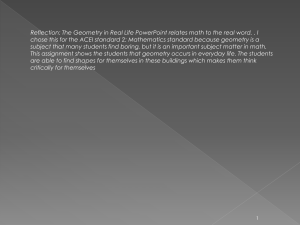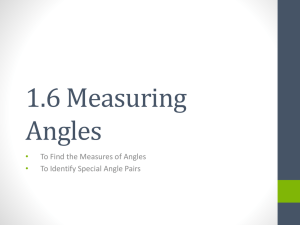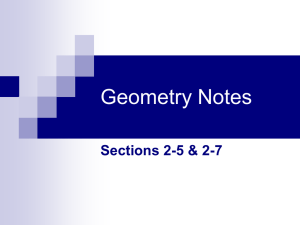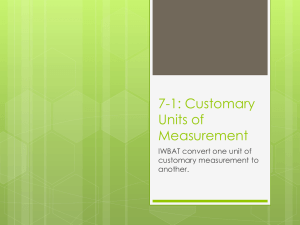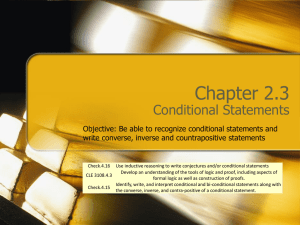Section 2-5: Proving Angles Congruent
advertisement
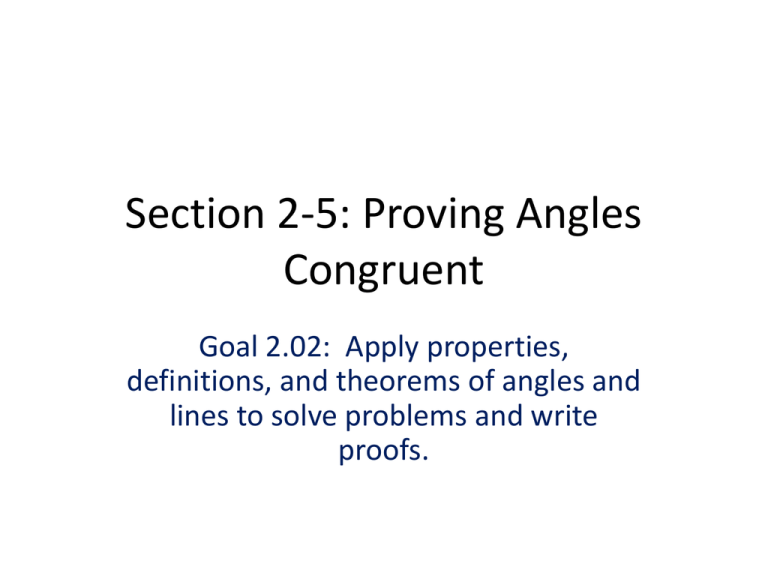
Section 2-5: Proving Angles Congruent Goal 2.02: Apply properties, definitions, and theorems of angles and lines to solve problems and write proofs. Homework Answers Properties from Algebra 1. addition property of equality 2. division property of equality 3. multiplication property of equality 4. subtraction property of equality 5. division property of equality 6. distributive 7. transitive 8. symmetric 9. addition property of equality 10. transitive 11. subtraction property of equality Justify the Statement Homework 1. definition of midpoint 2. definition of angle bisector 3. Angle Bisector Theorem 4. Angle Addition Postulate 5. definition of midpoint 6. Midpoint Theorem 7. Angle Addition Postulate 8. Segment Addition Postulate 9. definition of angle bisector Warm up • Lesson Quiz 2-4 • Checkpoint quiz p 88 (1-10) • Mixed Review: p 87 (38 – 44) Essential Questions 1. How are vertical, complementary, and supplementary angles identified? 2. What are the theorems about angles? 3. How are they applied? What are adjacent angles? Two angles side by side with a common vertex and common side. ( no common interior points and can’t overlap) ex. 1 ex. 2 Vertical Angles a. two angles whose sides form two pairs of opposite rays. b. when two lines intersect two pairs of vertical angles are formed. Complementary Angles two angles whose measures have the sum 90. Each angle is a complement of the other. x = angle ex. 1 90 – x = complement ex. 2 Supplementary Angles two angles whose measures have the sum 180. Each angle is a supplement of the other. x = angle 180 – x = supplement ex. 1 ex. 2 Reminders • Complementary and supplementary angles do not have to be adjacent angles. • Complementary will always be only 2 angles whose sum is 90. • Supplementary must always be 2 angles whose sum is 180. Examples p 100 (1-5) 1. 2. 3. 4. 5. Supplementary to AOD Adjacent and congruent to AOE Supplementary to EOA Complementary to EOD A pair of vertical angles P 100 (10 -18) 10. J = D 11. JAC = DAC 12. JAE and EAF are adjacent & supplementary 13. m JCA = m DCA 14. m JCA + m ACD = 180 15. AJ = AD 16. C is the midpoint of JD 17. EAF and JAD are vertical angles 18. AC bisects JAD Theorems 9. Vertical angles are congruent. 10. If two angles are supplements of the same angle (or of congruent angles), then the two angles are congruent. (Supplements of the same/ angles are .) 11. If two angles are complements of the same angle (or of congruent angles), then the two angles are congruent. (Complements of the same/ angles are .) 12.All right angles are congruent. 13. If two lines are perpendicular, then they form congruent, adjacent angles. 14. If two lines form congruent, adjacent angles, then the lines are perpendicular. 15.If the exterior sides of two adjacent acute angles are perpendicular, then the angles are complementary. Together: P 102 (39 – 53 odds, 57, 59) 39. 41. 43. 45. Congruent adjacent complementary angles 47. A and B are complementary: m A = 3x + 12 and B = 2x – 22 49. A is twice as large as its complement, B 51. A is twice as large as its supplement, B 53. The measure of B, complement of A, if 4 times the measure of C, complement of A. 57. 59. Groups of 2 to 3: Do p 102: 40 – 54 even, 58 Individual Practice • Worksheet: Practice 2-5 Assessment Standardized Test Prep: p 103 (60 – 66) Homework Worksheets: Proving Theorems Perpendicular Lines Study definitions, postulates and theorems for Multiple choice test Wednesday


